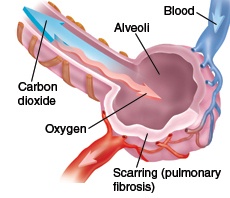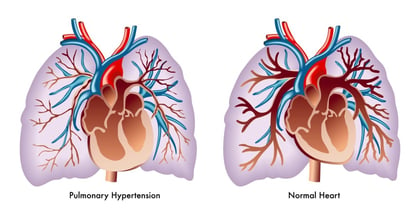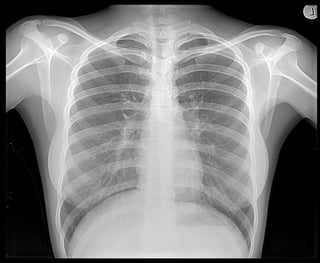This post was updated: 10/06/2016
Pulmonary Fibrosis has been diagnosed in around 140,000 Americans, and typically affects people in the age range of 50 to 75 according to the American Lung Association. Like most respiratory diseases, the affects of pulmonary fibrosis may develop more slowly or quickly in different people.
Table of Contents:
(Click to Jump to Different Sections)
1) What is Pulmonary Fibrosis?
2) Causes of Pulmonary Fibrosis
3) Pulmonary Fibrosis Symptoms
4) Risk Factors of Pulmonary Fibrosis
5) Complications of Pulmonary Fibrosis
6) Diagnosing Pulmonary Fibrosis
7) Treating and Managing Pulmonary Fibrosis
8) How to Live a High Quality Life with Pulmonary Fibrosis
9) How to Get the Most Out of Your Doctor's Appointments
Defining Pulmonary Fibrosis
Pulmonary Fibrosis(PF) is the keyword when describing thickened, stiff, and scarred lungs. As the tissue begins to scar and becomes thicker, the lungs have a harder and harder time delivering an adequate amount of oxygen into the bloodstream to keep up with the bodies demand.
When vital organs such as the heart or brain do not receive an appropriate amount of oxygen to supply the body’s needs then patients organs will not be able to function properly and effectively. There are cases where doctors can determine where the scarring came from, but usually the cause is unknown. When the cause of the scarring goes unknown doctors classify the disease as idiopathic pulmonary fibrosis.
The Causes - What Causes Pulmonary Fibrosis?
The causes of pulmonary fibrosis have been singled down into four separate categories, patients where the cause of their PF is unknown, patients whose disease has progressed from an autoimmune disease, constant exposure to pulmonary fibrosis causing agents, or those who have inherited the disease.
Unknown
When a patients pulmonary fibrosis has no signs of a single culprit behind the disease then doctors define the disease as Idiopathic Pulmonary Fibrosis.
What doctors believe is the underlying cause of this is the lungs have an abnormal response to damage, which in the end leads to further scarring of the lungs. Once doctors can determine the underlying causes of IPF, then many believe a wide array of new treatment options will be discovered and executed in the fight against idiopathic pulmonary fibrosis, and PF as a whole.
Exposure to Pollutants

This is especially common in patients that have worked in factories, carpentry, or any other profession that has patients constantly exposed to a lot of natural and man made pollutants.
Exposure to molds, fungus’, animal hair, asbestos, metal dusts, as well as gases and fumes can all lead to the development of pulmonary fibrosis. There have also been cases where exposure to certain medications, or radiation therapy have been the cause of patients developing PF. Like all lung diseases smoking is the number one cause for patients developing pulmonary fibrosis. Here are some tips to help you quit smoking.
Autoimmune Disease
Pulmonary fibrosis can also arise from a group of diseases referred to as systematic autoimmune disease. The common systematic autoimmune diseases are arthritis, acid reflex, diabetes, or even lupus can all lead to the development of pulmonary fibrosis.
PF is not the only lung disease that can form because of the previous diseases, the developed lung disease is based upon the underlying autoimmune disease but PF is the most common.
Genetics

Doctors commonly see patients whose pulmonary fibrosis is attributed to nothing more than genetics. Studies have shown that patients with a family history of PF or other lung diseases are automatically at a higher risk of developing PF.
Often times if the gene mutation is present in families then different family members can have different types of PF. Another study also shows that a present of specific genes can show which patients will have a faster progressing, more sever case of IPF.
Pulmonary Fibrosis Symptoms
- Shortness of Breath (Dyspnea)
- A Dry, Hacking Cough
- Fatigue
- Unexplained Weight Loss
- Aching Muscles and Joints
- Finger or Toe Clubbing
The symptoms above can largely vary between person to person, as some may become ill quickly and experience severe symptoms. While others will experience moderate symptoms that will develop more slowly.
Assessing the Risk Factors of Pulmonary Fibrosis
Lets now take a look at factors that increase your chances of developing pulmonary fibrosis:
Age
Although there have been cases of pulmonary fibrosis being diagnosed, this progressive respiratory disease typically affects people who are middle to older age (50-75+). If you currently are not diagnosed and experience the above symptoms and are also 50+, you should speak with your doctor about getting tested for PF.
Smoking

Smoking is the #1 cause of respiratory diseases such as COPD, and you guessed it, pulmonary fibrosis. It’s far more common for current or even past smokers to develop pulmonary fibrosis than a person who has never smoked. So whether you are currently diagnosed or think you have PF, do yourself a favor a quit smoking cigarettes/pipe tobacco/or cigars.
Work Occupation
If you currently work or have worked in the farming, mining, construction, carpentry, or other fields that frequently expose you to lung irritants, you are at a heightened risk for receiving a pulmonary fibrosis diagnosis.
Cancer Treatments
If you are currently receiving radiation therapy or are using chemotherapy drugs for cancer treatment or have in the past, due to its intense nature and damaging side effects, you are more likely to develop pulmonary fibrosis than someone who has not receive radiation therapy.
Genetic Factors
We mentioned this earlier as one of the main causes of PF, but there are specific types of pulmonary fibrosis that are hereditary. If respiratory illnesses run in your family, you should make an appointment for a lung function screening whether you experience any of the above symptoms or not.
Complications That May Arise Due to Pulmonary Fibrosis
If you or a loved one have received a diagnosis for pulmonary fibrosis, there are additional complications that may arise due to the respiratory disease that you should be aware of so you can pursue treatment sooner rather than later.
Pulmonary Hypertension (High Blood Pressure in Your Lungs)

What is pulmonary hypertension? Well it’s when there is high blood pressure in the arteries of your lungs, but don’t confuse this with systematic high blood pressure, as pulmonary hypertension strictly affects your lungs.
Pulmonary hypertension forms due to the scar tissue compressing the tiny arteries and capillaries, resulting in INCREASED blood flow resistance in your lungs. Which causes an increase in additional pressure within your right ventricle and pulmonary arteries.
Learn about the specific symptoms of pulmonary hypertension from the Mayo Clinic.
It’s important for you to be aware of the symptoms of pulmonary hypertension, so if you experience them you and your doctor can begin treating it. As pulmonary hypertension is extremely progressive and will get worse over time if left untreated, possibly even leading to death.
Right-Sided Heart Failure (Cor Pulmonale)
Due to partially blocked pulmonary arteries your heart’s lower right chamber (ventricle) has to work harder than usual to pump blood through your blocked arteries. This extremely serious and life-threatening condition is known as cor pulmonale. Due to cor pulmonale, your lower right ventricle becomes enlarged and thus causing it to pump blood less effectively. Which can lead to the ventricle ultimately failing.
Respiratory Failure
As your pulmonary fibrosis progresses into its later stages, you can have an increased risk of respiratory failure. This is due to the thick and stiff scarred tissue around the air sacs within your lung tissue. Restricting the flow of oxygen that is able to pass through the air sacs into your bloodstream. Making it increasingly difficult to breathe, and causing dangerously low levels of oxygen in your bloodstream.
As it becomes more difficult to breathe, you may also notice an increase in the occurrence of daily fatigue and loss of appetite.
Lung Cancer
When diagnosed with pulmonary fibrosis, the longer you have this progressive respiratory disease the more likely you are to develop lung cancer.
You should speak with your doctor in regards to avenues that you can pursue to effectively lower your chances of developing lung cancer or any of the other complications discussed above.
Additional Complications that May Develop Due to PF
- Blood Clots in Your Lungs
- Stroke
- Lung Infections
- Heart Attack
Tests Used to Diagnose Pulmonary Fibrosis

If you have been experiencing symptoms of pulmonary fibrosis, there are numerous tests that your doctor can pursue to properly diagnose you with PF. Which range from imagining tests, lung function tests, and tissue samples. Learn more about the tests used to diagnose pulmonary fibrosis below.
Imaging Tests
- Chest X-ray
- CT Scan (Computerized Tomography)
- Echocardiogram
Lung Function Tests
- Pulmonary Function Testing
- Oximetry
- Exercise Stress Test
Tissue Sample (Biopsy)
- Bronchoscopy
- Bronchoalveolar Lavage
- Surgical Biopsy
How You Can Treat & Manage Your Pulmonary Fibrosis
Following your diagnosis of pulmonary fibrosis, there are numerous treatment avenues that your doctor may pursue on their own or in combination. Treatment techniques range from medications, medical oxygen therapy, pulmonary rehab, or in some cases surgery.
Let’s take a deeper look into the varying treatment methods for pulmonary fibrosis, so you can take what you learn and discuss treatment options more in-depth with your doctor to find the most effective option(s) for your respiratory health.
Medications:
- Corticosteroid (Prednisone)
- Cyclosporine
- N-Acetylcysteine (NAC)
- Cyclophosphamide (Cytoxan)
- Azathioprine (Imuran)
- Mycophenolate Mofetil (Cellcept, Myfortic)
- Nintedanib (Ofev)
- Pirfenidone (Esbriet, Pirfenex, Pirespa)
- Proton Pump Inhibitors (Prilsec OTC, Nexium)
You can find a detailed explanation of each of the medications used to treat pulmonary fibrosis here.
Oxygen Therapy

Oxygen is the lifeline that your entire body depends on. But when diagnosed with pulmonary fibrosis the thick scar tissue around your lungs make it increasingly difficult for the air sacs in your lungs to deliver an adequate supply of oxygen into your bloodstream. Thus affecting the amount of oxygen that reaches your vital organs. Which is especially noticeable during physical activity.
To combat this you need to supplement the lack of supply of oxygen. To do this your doctor may prescribe medical oxygen. Which is available via oxygen tanks, home or portable oxygen concentrators. Depending on the severity of your pulmonary fibrosis, you may be prescribed to use oxygen during peak physical activities. On the other hand, if you constantly have low levels of oxygen you may be told to use oxygen all the time.
To help you stay on top of your ensuring you have adequate oxygen levels, you should purchase a hand held pulse oximeter. Which is a tiny little device that is pain free and typically slides over your index finger to provide you with an accurate reading of your blood oxygen levels.
With the addition of oxygen therapy you can have noticeable benefits in the severity and frequency of breathlessness, and can help you maintain the active lifestyle that is so vital in the overall management of your PF.
Pulmonary Rehab
Enrolling in a pulmonary rehab program is one of the most effective treatment options when faced with a pulmonary fibrosis diagnosis. Here you will have a well-rounded treatment plan developed specifically for your respiratory needs from a team of healthcare professionals.
While going through pulmonary rehab you will learn conditioning, exercise training and breathing exercises, nutritional counseling, stress, anxiety, and emotional management, further education into PF, and more.
Allowing you to take what you learned and apply it directly into your day to day management of pulmonary fibrosis. Helping you to function regularly without extreme levels of breathlessness.
Pulmonary rehab is a vital pillar for properly managing your PF, patients who have participated in pulmonary rehab have shown an increase in their overall exercise abilities, symptom management, and quality of life. Depending on your local pulmonary rehab, the program can be inpatient, outpatient, home/community based, or a combination.
Lung Transplant Surgery
If your doctor has exhausted all other treatment options with seemingly minimal results, your doctor may recommend a lung transplant as a last resort.
You can learn more about a lung transplant for pulmonary fibrosis from the National Heart, Lung, and Blood Institute here.
Necessary Lifestyle Adjustments to Live a High Quality of Life with Pulmonary Fibrosis
Diet: What You Eat Can Directly Impact Your Pulmonary Fibrosis
Diet and exercise are extremely important in order to live a happy and healthy life with pulmonary fibrosis. A diet packed with lots of vegetables, whole grains, fiber, lean-meat, and low fat dairy products will ensure a high quality and long lived life.
Patients also need to limit the amount of sodium, cholesterol, sugar, and fat intake. By eating multiple small meals throughout the day rather than 3 big meals, this will reduce the urge of overeating as well as becoming over full which will also help with breathing.
For some diet tips to helps improve your pulmonary fibrosis, here are a couple of excellent articles:
- A Healthy Diet for Pulmonary Fibrosis
- LIVESTRONG: Food for Pulmonary Fibrosis
- WebMD: Health Tips for IPF
Exercise
In addition to dieting a regular exercise plan needs to be established in order to live a healthy live with PF. It's already known that patients who are recently diagnosed with PF are afraid to exercise because of feelings of breathlessness. Which is why patients need to exercise so they can avoid their muscles deteriorating and becoming weaker, which makes doing every day activities even harder. Speak with your doctor to determine an exercise plan that would be beneficial in your fight against pulmonary fibrosis.
A side note to keep in mind while undergoing treatment for your pulmonary fibrosis is that a positive attitude and the help and support of friends and family can go a long way in how you feel, and how you perceive your treatment and outlook of your overall disease. Support groups are a great way to connect and interact with patients who suffer from PF and other life threatening lung diseases.
Get Vaccinated (Pneumonia Vaccination & Annual Flu Shot)
If you want to have an active role in the management of your pulmonary fibrosis, ensuring that you receive both a pneumonia vaccination and yearly flu shot is vital. The reason it’s so important to get vaccinated comes down to the fact that respiratory infections such as pneumonia can worsen your pulmonary fibrosis symptoms. Something you nor your doctor wouldn’t like to see.
It’s not only important for you to get vaccinated but also for your family. This will reduce the chances of your family from passing the illness off to your already damaged health. Another important factor to keep in mind is to avoid crowded areas during peak flu season (October-May in most places).
Quit Smoking & Avoid Second-Hand Smoke
As your lung tissues are already damaged due to pulmonary fibrosis, why risk further damaging them by smoking cigarettes?
1) It’s not worth it
2) Your family loves you and wants you to be around for as long as possible!
So do your health a favor and put down that nasty cigarette habit in exchange for better health. To further protect your lung health, you should avoid second-hand smoke at all costs. Meaning you should declare your home a smoke free environment by asking your friends and family not to smoke around you. Whenever you are out and about running errands or grabbing a bite to eat be sure to also avoid smoking sections at all costs.
Get Plenty of Rest or Risk Further Health Complications

Allowing your body to rest and recover from the day is what makes sleep not only necessary for healthy people but also for patients with pulmonary fibrosis. When diagnosed with an interstitial lung disease such as pulmonary fibrosis you should aim for 8 hours of sleep per night.
By sleeping for 8 hours each night you will effectively provide a boost to not only your immune system but also to your overall sense of well-being.
A lack of sleep each night can affect your daily energy levels, impairs your cognitive function, and can even lead to further health complications such as heart disease, heart attack, stroke, and more. Additionally, sleep deprivation can also contribute to symptoms of depression.
Learn & Master Relaxation Techniques
When faced with a progressive respiratory disease like pulmonary fibrosis you may begin to experience increased feelings of stress and anxiety due to your worsening shortness of breath. What’s more, breathlessness can also lead to feelings of depression due to its isolating effects that restrict you from many of your favorite activities that bring joy to your life.
However, there is no need to further exacerbate your feelings of anxiety as there are relaxation techniques that you can put into action to subside your increasing levels of anxiety.
Whether you experience anxiety or not, it’s important for you to know and understand the following relaxation techniques in the event you ever do. Here are a two of the many relaxation techniques that you can harness to alleviate your heightened feelings of anxiety:
- Deep Breathing Meditation: Deep breathing is a pillar of many relaxation techniques. The goal of deep breathing is to get you to focus on making full deep breaths. Which is done by breathing deeply from your abdomen to allow as much fresh air to enter your lungs as possible. On the other hand, when swallowing your breaths from your upper chest you are obtaining less oxygen than you would by taking deep breaths from your abdomen.
By effectively increasing your oxygen levels through the power of deep breathing, your breathlessness is reduced to a manageable level, and you feel less anxious and tense.
- Visualization Meditation: This relaxation technique is all about forming a mental image that guides you on a visual journey to a calm and serene place, situation, or memory. While performing visualization meditation you should try to harness as many of your senses as possible. This technique is most effective when you close your eyes and are in a quiet and peaceful area.
For example: Visualize yourself peacefully floating in the middle of the ocean, try to imagine the smell of the crisp air and the salt infested water, feel the warmth of the sun on your skin, and the sound of waves crashing in on the shore.
Additional Relaxation Techniques:
- Yoga
- Tai Chi
- Rhythmic Movement
- Progressive Muscle Relaxation
- Body Scan Meditations
- Music and Art Therapy
- Mindfullness Meditation
When first beginning to use varying relaxation techniques, it’s important to keep in mind that these are acquired skills and with any skill they take practice. By regularly practicing these relaxation methods your ability to relax will increase. Learn more about relaxation techniques from HelpGuide.org.
Stay motivated with the goal of improving your overall well-being with pulmonary fibrosis, so if one technique isn’t effective try another. If you are still having troubles relieving stress and anxiety, speak with your doctor about other possible options.
Maintain a Positive Attitude

Upon your pulmonary fibrosis diagnosis there are two ways you can react:
1) you can dwell on your disease and feel sorry for yourself
2) you can have a positive attitude and actively participate in the management of your pulmonary fibrosis.
If you choose to dwell on your respiratory disease and feel sorry for yourself, that will lead to a further decline in your mental health, increasing your chances of developing depression. Additionally, having a poor attitude can lead to worsening symptoms, isolating yourself from loved ones and enjoyable activities that only adds to feelings of depression.
Hopefully you choose to go with option 2. Keeping a positive attitude despite your declining lung function and loss of ability to do basic daily activities as easily as you once did. Will help you better cope with your progressive respiratory disease.
It can be easy to dwell on the negative aspects of your disease and overall life, but instead you should practice perceiving your declining health in a positive light. So what do I mean? Instead of stressing out about your shortness of breath, put a positive spin on it by telling yourself “I can get through this and shortness of breath will not consume me”.
Sure there will be times when you are feeling down, but that’s okay, it’s your ability to move onto more positive and outward thinking that is the key. An excellent tip to abide by is for every negative thing you think of, say 3 positive things about yourself.
5 Tips to Help You Maintain a Positive Attitude:
- Meditate Daily
- Keep a Journal of Positive Thoughts/Memories/Experiences
- Surround Yourself with a Support Group (Friends, Family, Like-Minded Patients)
- Take a Break and Have Fun
- Exercise Regularly
How to Get the Most Out of Your Health Care Visits
Regularly Educate Yourself on Pulmonary Fibrosis
No matter if you have been diagnosed with pulmonary fibrosis for sometime now, you should always brush up on your PF knowledge. Researchers and doctors alike are constantly working to develop new treatment options and reasearching to find a cure. Take an active role in your treatment and regularly educate yourself on new developments or treatments for PF.
Enroll in a Support Group (Online or In-Person)

Nobody quite understands you or what you’re going through better than other patients who are also diagnosed with pulmonary fibrosis. Which is exactly why you should enroll in a support group either locally or online. Find a support group near you here. Support groups are an excellent place to learn, share thoughts, experiences, worries, and fears with patients who can directly relate.
Speak with Close Friends or Family
If you don’t feel comfortable communicating with strangers or unable to participate in a support group due to lack of availability, talking with your friends and loved ones is an excellent option to receive emotional support when trying to exercise, quit smoking, or improving your diet. Additionally you can share your feelings, worries, and fears with them without the fear of being judged. Plus no-one will support you in improving your health more than your loved ones and close friends.
Speak Up for Yourself
If you don’t fully understand something your doctor says in regards to specific prescribed treatments, or your pulmonary fibrosis as a whole speak up and ask your doctor for further instructions and clarification. Remember that your doctor is there to assist you on your path to improved health so any issues or concerns you may have your health care team will be more than happy to assist.
Be Prepared for Your Healthcare Visits
While going throughout your day to day routines with PF, if you have any questions, notice an increase of any symptoms, or the development of new ones, jot them down in a journal and bring it to your next visit with your doctor. This way you won’t have to try to remember issues or questions you may have had or experienced and can refer back to your journal and speak with your doctor about ways to combat the arise of new symptoms, worries, or fears. It’s nearly impossible to take an active role in your PF treatment if you are unaware of what exactly is going on with your respiratory disease.
Take Notes During Your Visit

Visiting your doctor can provide you with a significant amount of new information, which can be hard to fully obtain and often overwhelming. To prevent forgetting an important piece of information from your doctor bring a note pad and paper with you and take notes during your visit. Or you can simply pull out your smartphone and take notes on there, both options are excellent.
Conclusion
Whether you or a loved one are apart of the 140,000 Americans that are diagnosed with pulmonary fibrosis, you shouldn’t wait until the disease progresses to take action. Instead you should have an active role in the management of your respiratory disease from the get go.
Doing so will increase your lifestyle quality as well as help reduce the overall restrictive nature of this progressive respiratory disease.
What are some tips that you found extremely viable upon your diagnosis that you would like to share with other newly diagnosed PF patients? Leave your tips in a comment below.
And don’t forget to share this post (share link to social media) with fellow pulmonary fibrosis patients!
If you're looking to get a portable oxygen concentrator to help treat your pulmonary fibrosis, download our Official Guide to Portable Oxygen Concentrators and see if a concentrator is going to enhance your life!







